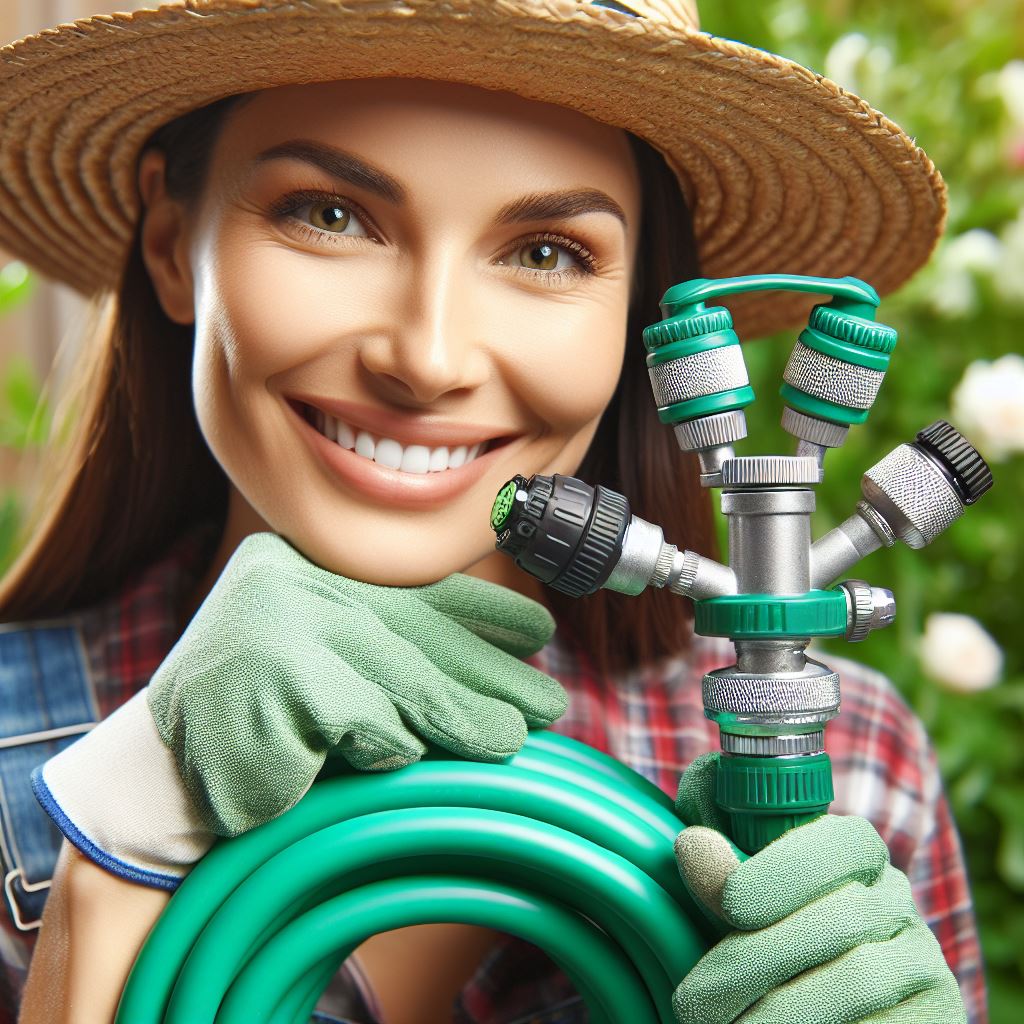Introduction
Efficient watering systems are vital for small gardens to ensure optimal water usage.
Importance of efficient watering systems for small gardens
Drip irrigation or soaker hoses deliver water directly to plant roots, minimizing evaporation and runoff.
This precision conserves water and fosters healthier growth, particularly crucial in limited spaces.
With automated timers, you can maintain consistency even during busy schedules.
Investing in efficient watering systems not only saves time and resources but also nurtures flourishing green havens in confined urban landscapes.
The focus of the blog post
In this blog post, we will explore different systems that can help minimize water wastage and maximize plant health.
Traditional Watering Systems
Traditional watering methods, such as hand watering, hose watering, and sprinklers, have several limitations and drawbacks that hinder their efficiency.
These include:
Time-consuming
Hand watering and hose watering can be labor-intensive and require a significant amount of time.
This is especially true for larger gardens.
Inconsistent water distribution
With hand watering or using a hose, it is challenging to ensure even water distribution across the entire garden, leading to overwatering some areas and underwatering others.
Water wastage
Traditional methods often result in significant water wastage due to overspray or evaporation, especially when using sprinklers.
Limited control
The lack of control over water flow and pressure limits the precision and effectiveness of traditional watering methods.
Inefficient water absorption
When using sprinklers or hose watering, a significant amount of water can be lost to runoff or absorbed by non-vegetative surfaces instead of reaching the plant roots.
Dependency on manual intervention
Traditional systems require constant manual monitoring and adjustment, which may not always be practical for gardeners, especially when they are away or have other commitments.
Transform Your Agribusiness
Unlock your farm's potential with expert advice tailored to your needs. Get actionable steps that drive real results.
Get StartedConsidering these limitations and drawbacks, there is a clear need for a more efficient approach to watering small gardens.
Modern innovations and technologies can help overcome these challenges and improve water usage in gardens.
Read: Edible Landscaping: Beauty and Bounty
Drip Irrigation Systems
Drip irrigation is a highly efficient method of watering plants by delivering water directly to the roots, minimizing water loss and maximizing plant health.
The benefits of drip irrigation are numerous.
Firstly, it conserves water by delivering it directly to the root zone, reducing evaporation and runoff.
This makes it an ideal choice for small gardens, where water conservation is crucial.
In small gardens, drip irrigation works by installing a network of tubes that carry water from the source to each plant.
These tubes are strategically placed near the plants’ root zone, ensuring that the water goes directly to where it is needed most.
Components of a drip irrigation system
The components of a drip irrigation system include tubing, drippers, pressure regulators, filters, and emitters.
The tubing serves as the main channel for water delivery, while the drippers control the flow of water to each plant.
Pressure regulators ensure that the water pressure remains consistent throughout the system, and filters prevent clogging.
One of the major advantages of drip irrigation in small gardens is its ease of installation.
The system can be set up quickly and easily, requiring minimal tools and expertise.
Additionally, it is flexible and can be customized to fit any garden layout.
Maintenance is also a breeze with drip irrigation.
The system requires regular monitoring to ensure that the tubes and drippers are working properly and are not clogged.
Cleaning and replacing parts are straightforward tasks that can be done by the gardener without professional assistance.
Moreover, drip irrigation allows for precise control over watering, as the flow rate can be adjusted to suit the specific needs of each plant.
This ensures that plants receive the right amount of water, minimizing waste and preventing overwatering or underwatering.
Furthermore, drip irrigation systems are compatible with various water sources, including mains water, rainwater tanks, and even greywater systems.
This versatility makes them suitable for different gardening setups and environmentally conscious practices.
Another benefit of drip irrigation is its ability to reduce weed growth.
By delivering water directly to the plants’ root zone, the surrounding soil remains dry, inhibiting weed germination and growth.
Showcase Your Farming Business
Publish your professional farming services profile on our blog for a one-time fee of $200 and reach a dedicated audience of farmers and agribusiness owners.
Publish Your ProfileThis saves time and effort spent on manual weeding.
In essence, drip irrigation is an excellent watering system for small gardens.
Its efficiency, water conservation capabilities, ease of installation and maintenance, and ability to provide precise and customized watering make it a popular choice.
By investing in a drip irrigation system, gardeners can ensure healthier, more vibrant plants while saving water and time.
Read: Soil pH Matters: Testing and Adjusting Tips
Micro-Sprinkler Systems
Introducing micro-sprinkler systems as an alternative to traditional sprinklers offers several advantages for small gardens.
Advantages of Using Micro-Sprinklers in Small Gardens
- Saves water
- Provides targeted watering
- Reduces evaporation
- Prevents soil erosion
- Allows for customizable irrigation
- Minimizes weed growth
- Avoids overwatering
- Improves overall plant health
Micro-sprinkler systems are easy to set up and operate, making them ideal for small gardens.
Setup and Operation of Micro-Sprinkler Systems
To set up a micro-sprinkler system, follow these simple steps:
- Choose the appropriate micro-sprinklers for your garden’s needs.
- Attach the micro-sprinkler heads to a water source, such as a garden hose or drip irrigation line.
- Position the micro-sprinklers evenly throughout your garden, considering plant spacing and watering requirements.
- Adjust the flow rate and coverage area of each micro-sprinkler to ensure even watering.
- Regularly check and maintain the system to prevent clogs or leaks.
Operating a micro-sprinkler system is as simple as turning on the water source and allowing the micro-sprinklers to distribute water evenly.
How do micro-sprinkler systems help conserve water in small gardens?
Micro-sprinklers target water directly to the root zone of plants, minimizing water waste and promoting efficient absorption.
The even distribution of water through micro-sprinkler systems helps prevent overwatering, reducing water consumption and saving resources.
Additionally, micro-sprinklers reduce evaporation by delivering water closer to the ground, ensuring that more water reaches the plants’ roots.
By preventing soil erosion, micro-sprinkler systems enhance water retention in the garden, reducing the need for frequent watering.
The customizable nature of micro-sprinkler systems allows gardeners to cater to each plant’s specific watering needs, preventing underwatering or overwatering.
Furthermore, micro-sprinklers provide targeted watering, minimizing water waste on areas without plants or in between garden beds.
Less weed growth is observed with micro-sprinkler systems, as they only water the designated plant areas, leaving weed-prone regions dry.
Overall, micro-sprinkler systems contribute to improved plant health and vitality by providing consistent and efficient water distribution.
In general, micro-sprinkler systems offer several advantages for small gardens, including water conservation, customizable irrigation, and improved plant health.
By understanding the setup and operation of micro-sprinklers, gardeners can make informed decisions to enhance their watering systems.
Read: Herb Gardening: Flavorful and Easy

Explore Further: Beat Garden Pests: Safe, Natural Methods
Rainwater Harvesting Systems
Rainwater harvesting is the process of collecting and storing rainwater for future use.
This sustainable practice has numerous benefits for small gardens and the environment.
One method of collecting rainwater is through the use of rain barrels
Rain barrels are containers that capture rainwater from rooftops and store it for later use.
These barrels can be placed under downspouts and equipped with screens to filter debris.
They are easy to install and can hold a significant amount of water to sustain a small garden.
Cisterns are another option for rainwater storage in small gardens.
These larger containers can hold a greater volume of water than rain barrels.
Cisterns can be installed underground or above-ground, depending on available space.
Underground tanks are ideal for maximizing garden space and maintaining an aesthetically pleasing appearance.
Advantages of using rainwater for irrigation
Rainwater harvesting offers several advantages for irrigation purposes in small gardens:
- Reduced water bills: By using rainwater, gardeners can conserve tap water and reduce their monthly expenses.
- Eco-friendly: Rainwater is a natural resource that does not contain chlorine or other chemicals present in tap water.
- pH balance: Rainwater is naturally slightly acidic, making it ideal for certain plants that prefer acidic soil.
- Nutrient-rich: Rainwater contains minerals and nutrients that can benefit plants more effectively than tap water.
- Less stress on municipal water supply: By utilizing rainwater, the demand for municipal water decreases, providing relief to water utilities.
- Better plant growth: Plants thrive on rainwater due to its purity and the absence of harmful substances found in tap water.
- Environmental impact: Rainwater harvesting reduces runoff, preventing erosion and pollution of rivers and lakes.
- Self-sufficiency: With a rainwater harvesting system, gardeners become less dependent on external water sources.
In summary, rainwater harvesting systems provide an efficient solution for watering small gardens.
Whether utilizing rain barrels, cisterns, or underground tanks, gardeners can experience the benefits of rainwater.
By reducing water bills, promoting plant growth, and minimizing environmental impact, rainwater harvesting is a win-win practice.
Read: Container Gardening: Grow Veggies Anywhere
You Might Also Like: Backyard Berry Bonanza: Growing Guide
Smart Irrigation Systems
Smart irrigation systems introduce a revolutionary approach to watering plants in small gardens.
These systems incorporate advanced technology to optimize water usage and ensure efficient watering.
Showcase Your Farming Business
Publish your professional farming services profile on our blog for a one-time fee of $200 and reach a dedicated audience of farmers and agribusiness owners.
Publish Your ProfileThrough weather-based scheduling, smart irrigation systems adjust watering based on current weather conditions.
How these systems utilize advanced technology for efficient watering
Automatic adjustments are made to the watering schedule, ensuring plants receive the right amount of water at the right time.
One of the key features of smart irrigation systems is weather-based scheduling.
Weather-based scheduling takes into account factors like temperature, humidity, and rainfall to tailor the watering schedule.
This intelligent approach prevents overwatering, which is a common issue in traditional irrigation methods.
By adjusting watering based on weather conditions, smart irrigation systems save water and promote water conservation.
Another advantage of smart irrigation systems is their ability to detect soil moisture levels
Through soil moisture sensors, these systems can measure the moisture content in the soil.
When the soil becomes too dry, the system automatically triggers watering, preventing dehydration of plants.
Conversely, if the soil is already moist, the system will skip watering to avoid water wastage.
Smart irrigation systems also have the capability to adapt to changes in plant water requirements.
They can learn the specific needs of different plants and adjust the watering duration and frequency accordingly.
This customization ensures that each plant receives the appropriate amount of water for optimal growth.
By delivering water directly to the root zone of plants, smart irrigation systems minimize water loss due to evaporation.
This targeted approach maximizes water efficiency and reduces water consumption in small gardens.
In addition to water conservation, smart irrigation systems offer potential cost savings for garden owners.
Potential cost savings and water conservation achieved with smart irrigation
By using water more efficiently, these systems can lead to reduced water bills and lower maintenance costs.
Furthermore, smart irrigation systems contribute to environmental sustainability by conserving a precious resource.
With their advanced features and intelligent capabilities, these systems provide an eco-friendly solution for small gardens.
Overall, smart irrigation systems revolutionize the way we water plants in small gardens.
Through their innovative technology and efficient watering techniques, they promote water conservation and sustainability.
With weather-based scheduling, automatic adjustments, and customization options, these systems ensure plants receive optimal care.
Investing in smart irrigation systems not only benefits garden owners but also contributes to a greener future.
Conclusion
Recap of the importance of efficient watering systems for small gardens
In closing, efficient watering systems are crucial for small gardens.
They ensure proper hydration for plants and prevent water wastage.
Advantages of using drip irrigation, micro-sprinklers, rainwater harvesting, or smart irrigation
There are several advantages to using drip irrigation, micro-sprinklers, rainwater harvesting, or smart irrigation.
Drip irrigation allows for precise water distribution, preventing over-watering and reducing water usage.
Micro-sprinklers provide a fine mist that reaches the roots without wasting water.
Rainwater harvesting helps utilize natural rainfall and reduces reliance on municipal water sources.
Smart irrigation systems use sensors and timers to optimize watering schedules and conserve water.
When selecting a watering system, it is important to consider the specific needs and constraints of your garden.
Factors such as plant type, soil type, sun exposure, and water availability should be taken into account.
Encouragement to choose a system based on their garden’s specific needs and constraints
Choose a system that best suits your garden’s requirements.
Efficient watering systems not only save water, but also save time and effort.
They promote healthy plant growth and prevent water-related issues such as waterlogging or drought stress.
By investing in these systems, gardeners can create sustainable and thriving gardens.
Overall, efficient watering systems are essential for small gardens.
Choose the right system for your garden and enjoy the benefits of water conservation and plant health.
Let’s make our gardens greener and more sustainable.




